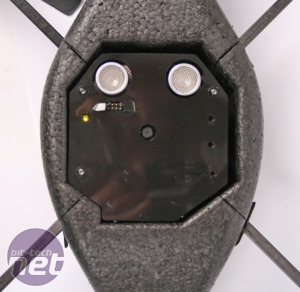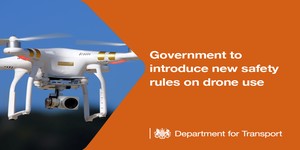
Performance
We’re not entirely sure how to review the AR.Drone. We contemplated attempting to run our benchmark suite on it, but with an ARM9 processor and 128MB RAM it would likely take weeks to complete. We’d also have to mount a hard disk to it, significantly reducing battery life - an SSD would be nice and light though... where’s the Dremel?Seriously though, to test the AR.Drone we gave it a good thrashing around our labs and then let it stretch its legs a little more out on our outdoor decking area.
The AR.Drone worked flawlessly with the iPhone app - we expected the usual rigmarole of wireless networking, but it was simple and easy to connect to the 'copter. In case you were wondering, you do tie a single control device to a single AR.Drone, meaning that bigger boys can’t come along and nick your 'copter from you with their own iPhone and app.
The AR.Drone was also remarkably stable when in its default hover state, we could prod it and push it while it was hovering at waist level and it would stay stable and calm. We also plucked up some courage and stuck a finger into the running blades (how we suffer for our rigorous testing methodology) and while it smarted a bit, the AR.Drone detected the obstruction and immediately shut of its rotor blades. This resulted in it crashing to the floor but it’s better than it chewing through whatever comes into contact with its blades.
Crashing was something the AR.Drone had to get used to though, as we regularly got rather ambitious with our piloting, sending the poor thing careering into various walls, cabinets and sometimes people. Maybe we shouldn’t have been wearing the aviator glasses and listening to the Air Wolf theme tune so loudly. We’ll know for next time.
To its credit, the AR.Drone coped well with the knocks. It continued running, and the indoor shell didn’t deform or break despite continued punishment.
We did find the controls a little difficult to get to grips with initially, but we got better with practice. We could imagine people getting pretty nimble with the thing if you played with it regularly. There are some impressive videos up on the AR.Drone site showing what it can do when it’s controlled well to prove the point.
We should mention that in small rooms the four blades of the AR.Drone were loud, but in larger rooms the noise wasn't so overwhelming. When outdoors we didn't find the angry buzz of the blades to be a nuisance at all.


Left: The ultrasound altimeter uses two sensors to gauge the AR.Drone's hight. Right: The camera streams its output to the iPhone screen. Click to Enlarge
Conclusion
The AR.Drone is fun and accessible to play with. It’s also impressive that's it's so easy to set up and how quickly the 'copter can be zipping around the room after getting it out of the box. We certainly enjoyed hovering the AR.Drone around our labs, trying to land it on each other's hands and generally fooling about.Unfortunately that’s all the AR.Drone is worth getting for: fooling about. There’s no denying it's fun to play with, but at £300 we'd like it have done more - would fetching beers from the fridge be too much to ask? The price only includes one battery too, which means a maximum play-time of 13 minutes between charging.
The tech in the AR.Drone is impressive though, and for the guy or girl who has everything it's a great gadget. If Apple can persuade people to spend £429 on a iPad, we're sure that Parrot can find a few RC 'copter fans that will enjoy playing laser tag, either with the augmented reality game or with another AR.Drone owner. The AR.Drone may be an amazing RC 'copter, but you'd have to be a serious RC enthusiast to buy one.
- Design
- x
- x
- x
- x
- x
- x
- x
- x
- -
- -
- 8/10
- Value
- x
- x
- x
- x
- x
- -
- -
- -
- -
- -
- 5/10
- Ease of Use
- x
- x
- x
- x
- x
- x
- x
- x
- -
- -
- 8/10
- Overall
- x
- x
- x
- x
- x
- x
- x
- -
- -
- -
- 7/10

MSI MPG Velox 100R Chassis Review
October 14 2021 | 15:04








Want to comment? Please log in.